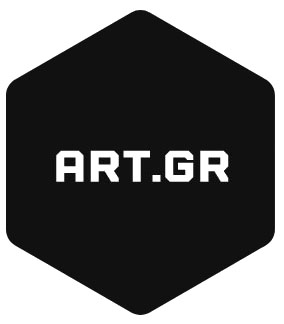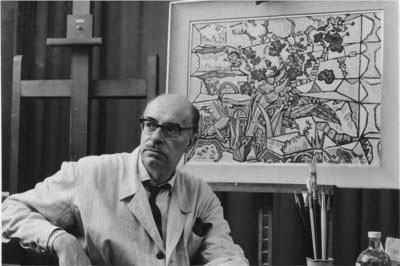Nikos Hatzikyriakos-Ghikas was born in Athens on February 26, 1906. From a young age he showed a special inclination towards drawing and so, while still a student, he took painting lessons from Konstantinos Parthenis.
In 1922 he went to Paris, where alongside his studies in French Philology and Aesthetics at the Sorbonne, he attended painting and engraving classes at the Académie Ranson, with Bissière and D. Galani as teachers.
He holds his first exhibition in Paris in 1923, at the Salon des Tuileries and the Salon des Surindependants, and then participates in many group exhibitions.
His first solo exhibition was organized in Paris in 1927 at the Galerie Percier, while his first exhibition in Athens, at the Stratigopoulou Hall in 1928, was co-located with the works of the sculptor Michalis Tombrou.
Already an accomplished artist in 1934, he leaves Paris and comes to settle in Athens.
In 1935-1937 Gikas collaborates with the architect D. Pikionis, the poet T. Papatzonis and the director D. Karatinos in the publication of the magazine “To Trito Mati”.
In 1937, he repairs the house of the Ghika family in Hydra, where he paints his first works in which he definitively finds himself, combining the lessons of cubism with the nature, light and architecture of Greece.
In 1941 he was elected a professor at the Department of Design at the School of Architects of the National Technical University of Athens, where he taught until 1958.
In 1972 he was elected a regular member of the Athens Academy and in 1986 an honorary member of the Royal Academy of Arts in London. He was awarded an honorary doctorate of the Department of Architecture of the Polytechnic School of the University of Thessaloniki (1982) and an honorary doctorate of the Faculty of Philosophy of the University of Athens (1991).
More than 50 exhibitions of the artist have been organized from time to time in Athens, Paris, London, Geneva, Berlin, New York.
His works are in many private collections in Greece, Western Europe and the United States, as well as in many museums, such as the Musée d’art moderne in Paris, the Tate Gallery in London, the Metropolitan Museum of Art in New York, in the National Gallery of Athens.
Hatzikyriakos-Ghikas, in addition to painting, sculpture and engraving, was also involved in scenography, designing sets and costumes for several theatrical works, such as “The Clouds” by Aristophanes (National Theater 1951, Comédie française 1952), the ballet ” Persephone” by A. Gide with music by I. Stravinsky (Covent Garden 1961). He also illustrated a variety of books, including “Odyssey” by N. Kazantzakis, “Daphnis and Chloe” by Logos, “Poems” by K. Cavafy, and authored books, studies and articles on Architecture and Aesthetics, as well as essays on Greek art.
The artist dies on September 3, 1994.
Ο Νίκος Χατζηκυριάκος-Γκίκας γεννιέται στην Αθήνα στις 26 Φεβρουαρίου του 1906. Από μικρός δείχνει ιδιαίτερη κλίση στο σχέδιο και έτσι, μαθητής ακόμα, παίρνει μαθήματα ζωγραφικής από τον Κωνσταντίνο Παρθένη.
Το 1922 πηγαίνει στο Παρίσι, όπου παράλληλα με τις σπουδές του στη Γαλλική Φιλολογία και την Αισθητική στη Σορβόνη, παρακολουθεί μαθήματα ζωγραφικής και χαρακτικής στην Académie Ranson, με δασκάλους τον Bissière και τον Δ. Γαλάνη.
Πραγματοποιεί την πρώτη του έκθεση στο Παρίσι το 1923, στο Salon des Tuileries και στο Salon des Surindependants και στη συνέχεια συμμετέχει σε πολλές ομαδικές εκθέσεις.
Η πρώτη του ατομική έκθεση οργανώνεται στο Παρίσι το 1927 στην Galerie Percier, ενώ η πρώτη του έκθεση στην Αθήνα, στην Αίθουσα Στρατηγοπούλου το 1928, συστεγάζεται με τα έργα του γλύπτη Μιχάλη Τόμπρου.
Καταξιωμένος ήδη καλλιτέχνης το 1934, εγκαταλείπει το Παρίσι και έρχεται να εγκατασταθεί στην Αθήνα.
Στα 1935-1937 ο Γκίκας συνεργάζεται με τον αρχιτέκτονα Δ. Πικιώνη, τον ποιητή Τ. Παπατζώνη και το σκηνοθέτη Δ. Καραντινό στην έκδοση του περιοδικού «Το Τρίτο Μάτι».
Το 1937 επισκευάζει το σπίτι της οικογένειας Γκίκα στην ‘Υδρα, όπου ζωγραφίζει τα πρώτα του έργα στα οποία βρίσκει οριστικά τον εαυτό του, συνδυάζοντας τα διδάγματα του κυβισμού με τη φύση, το φως και την αρχιτεκτονική της Ελλάδας.
Το 1941 εκλέγεται καθηγητής στην έδρα του Σχεδίου της Σχολής Αρχιτεκτόνων του Εθνικού Μετσοβίου Πολυτεχνείου, όπου και διδάσκει ως το 1958.
Το 1972 εκλέγεται τακτικό μέλος της Ακαδημίας Αθηνών και το 1986 επίτιμο μέλος της Royal Academy of Arts του Λονδίνου. Ανακηρύσσεται επίτιμος διδάκτωρ του Τμήματος Αρχιτεκτόνων της Πολυτεχνικής Σχολής του Πανεπιστημίου της Θεσσαλονίκης (1982) και επίτιμος διδάκτωρ της Φιλοσοφικής Σχολής του Πανεπιστημίου των Αθηνών (1991).
Περισσότερες από 50 εκθέσεις του καλλιτέχνη έχουν οργανωθεί κατά καιρούς στην Αθήνα, το Παρίσι, το Λονδίνο, τη Γενεύη, το Βερολίνο, τη Νέα Υόρκη.
‘Εργα του βρίσκονται σε πολλές ιδιωτικές συλλογές στην Ελλάδα, στη Δυτική Ευρώπη και στις Ηνωμένες Πολιτείες, καθώς και σε πολλά μουσεία, όπως στο Musée d’art moderne του Παρισιού, στην Tate Gallery του Λονδίνου, στο Metropolitan Museum of Art της Νέας Υόρκης, στην Εθνική Πινακοθήκη της Αθήνας.
Ο Χατζηκυριάκος-Γκίκας εκτός από τη ζωγραφική, τη γλυπτική και τη χαρακτική, ασχολήθηκε και με τη σκηνογραφία, σχεδιάζοντας σκηνικά και κοστούμια για αρκετά θεατρικά έργα, όπως οι «Νεφέλες» του Αριστοφάνη (Εθνικό Θέατρο 1951, Comédie française 1952), το μπαλέτο «Περσεφόνη» του A. Gide με μουσική I. Stravinsky (Covent Garden 1961). Επίσης, εικονογράφησε ποικιλία βιβλίων, μεταξύ των οποίων την «Οδύσσεια» του Ν. Καζαντζάκη, το «Δάφνης και Χλόη» του Λόγγου, τα «Ποιήματα» του Κ. Καβάφη, και συνέγραψε βιβλία, μελέτες και άρθρα για την Αρχιτεκτονική και την Αισθητική, καθώς και δοκίμια για την ελληνική τέχνη.
Ο καλλιτέχνης πεθαίνει στις 3 Σεπτεμβρίου του 1994.
Biography Source | Πηγή Βιογραφικού: https://www.benaki.org/




